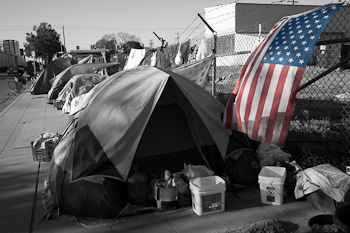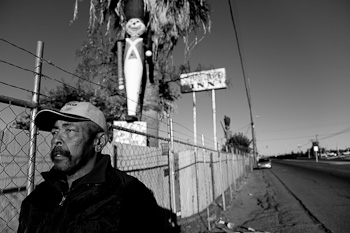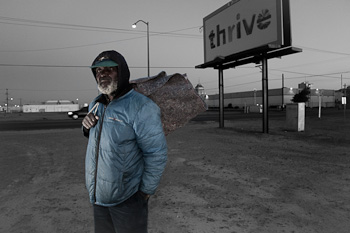Housing Fresno’s Homeless: A tale of lawsuits, lost identity and innovation

Photo by Jeff Pflueger
Written by Jeff Pflueger
Fresno, California
The city of Fresno, California is struggling under enormous pressures due to poverty.
A 2006 Brookings Institution report, using 2000 census data, ranks Fresno as having the 4th highest poverty rate in the nation – at 26.2%. But Fresno ranks 1st on a perhaps more important figure; with a 43.5% concentrated poverty rate, or the percentage of poor individuals in high-poverty neighborhoods, Fresno’s poor are geographically concentrated like nowhere else in the nation.
By city estimates, roughly one in a hundred people in Fresno, California are homeless. According to some homeless advocates the number is much higher; if the homeless also includes the people who are “displaced,” i.e. without a home, but living temporarily in some form of shelter like a motel room, the number could be as high as 1 in 20.
Across the city homeless encampments have swelled into villages. Each has is name like “The Hill,” “New Jack City,” and “F Street.”
They are comprised mostly of camping tents packed closely together. Sleeping bags, blankets and tarps are often draped over the tents to provide additional insulation and weather proofing. Some homes within the encampments are shanties made of freely available materials such as pallets, plywood and blankets.
Fresno, Cal Trans and the Fresno Police addressed the homeless situation by conducting coordinated “sweeps” of the encampments. After police ordered residents to leave, bulldozers scooped up entire settlements and literally threw them away. People were stripped of everything that they owned – and literally their identity – as birth certificates, identification, family photos, along with their meager possessions were heaped into bins destined for the landfill.
In October of 2006, a Federal Judge issued a temporary restraining order to stop the city from its illegal sweeps. Soon after, the homeless of Fresno won a rare victory: a $2.35 million dollar class action lawsuit against the city of Fresno and Cal Trans. Funds from the lawsuit went to the individuals whose possessions were destroyed in the illegal sweeps, as well as into an account to provide housing and medical care for the individuals in the class.

Photo by Jeff Pflueger
Since the settlement, the city of Fresno has changed its behavior. Fresno now pays consenting motels $65 a night to house a homeless person. After the voucher period is over, the people are most often back on the streets. Many of these hotels are dangerously run down. Recently, the city of Fresno closed the “StoryLand Inn,” one of the voucher motels, evicting as many as 100 residents for building code violations regarding mold, broken windows, and bad plumbing.
Fresno also began housing homeless people in tool sheds.
In October 2009, Fresno dismantled the “H Street” camp and relocated the estimated 150 residents at a cost of $700,000. Many of H Street residents were moved into “The Village of Hope”, a settlement made of dozens of plywood tool sheds packed into two fenced lots. Residents live two to a shed, without electricity, water, or insulation. Nobody can be in a shed between the hours of 8am to 5pm.
As bleak and violent as the homeless situation has become in Fresno, Fresno is a city desperately in need of creative solutions. Local architect Art Dyson believes that he can help.
After Dyson received a Masters of Architecture, he served his architectural apprenticeships with Frank Lloyd Wright, Bruce Goff, and William Gray Purcell. His work has received over 150 local, state, national, and international design awards and he is featured in more than 400 publications and in over two dozen books.
If anything, Dyson’s work is integrative, drawing upon many traditions and ideas. His approach to helping the homeless situation is perhaps the most integrative of all – and the most visionary.
“All marvels of history would have been history without bold decisions,” Dyson writes in the proposal for his project to help the homeless situation.
Dyson is creating a visionary program through Fresno Pacific University. The program is interdisciplinary, integrating sociology, anthropology, planning, architecture, and revolutionary ideas from sustainable building to create “Eco Villages” to house the homeless. The students in the program will design and ultimately build the villages with the assistance of volunteers and the homeless themselves.
Each village will be limited to 20 residents. Small private shelters, built from reused and sustainable materials, will be arranged around common community space and centered on a small scale local economy such as the production of bamboo, and crafts created from bamboo.

Photo by Jeff Pflueger
Due to the recent housing collapse, land is cheap in Fresno, and the villages themselves can be built for next to nothing claims Dyson, since the materials will be either reused or donated.
Dyson dreams that the villages will be easily replicable, making their work in Fresno a model for how cities around the globe can help people without homes.
As ambitious and technical his plans are, Dyson’s vision is rooted in a deeper passion about engaging and connecting people experientially through the process of the project. Dyson writes in his proposal, “The program will help cultivate a culture of mutual acceptance and respect, solidarity and compassion, open communication and cross-cultural outreach by example. The program will serve as a catalyst to produce the highest aspirations of humanity into a practical reality.”
The program has already started. Al Williams and Cynthia Green, two of the homeless people named as plaintiffs in the lawsuit against the Fresno for the sweeps of the encampments, were able to collectively invest $16,000 to purchase a home that will become the Pamela Kincaid Neighborhood Center.
Art Dyson and some other investors also chipped in to purchase the $28,000 dollar home that sits on 1/3 of an acre. The center is to be a place to help the homeless.
Dyson already has plans drawn for the development of the center and is actively looking for land now to allow his students and the Fresno community to build the first of the Eco Villages in Fresno.
_____________
Jeff Pflueger is a San Francisco based photographer with work published in the New York Times, National Geographic Adventure and other publications. This piece is from Jeff’s personal project about poverty in California. Read more about the project at CAStories.com.
If you enjoyed this post, why not Subscribe to SHELTER in your favorite reader?









[…] This post was mentioned on Twitter by Lee Schneider, Docu Cinema. Docu Cinema said: Housing Fresno’s Homeless: A tale of lawsuits, lost identity and innovation http://bit.ly/iQSCe (via feedly) […]
[…] DocuCinema’s new SHELTER blog, photographer Jeff Pflueger has posted a story about recently homeless people seeking justice. The post links back to some terrific multimedia […]
[…] DocuCinema’s new SHELTER blog, photographer Jeff Pflueger has posted a story about recently homeless people seeking justice. The post links back to some terrific multimedia […]
Sad and outrageous , we all hope for better times !
[…] Jeff Pflueger has posted a story about recently homeless people seeking justice. The post links back to some terrific multimedia […]
This collaboration is actually being done with California State University, Fresno. I am a member of eco-village, and representing from the Construction Management Program.
camping tents with polyurethane fabric can withstand the water and snow much better than vinyl *~”
‘~: I am very thankful to this topic because it really gives great information :*;
Use used cargo containers for housing. A 40 footer can be bought for less than $3,000, use two inch thick polystyrene panels (w/ glue ab’t $25 each–need about 33 panels), put in well insulated windows and a door at the end, small bedroom (ab’t 6 foot by 7 foot–with the bed on top of the closet 4 feet up), small kitchen with energy efficient fridge, microwave. The whole would cost less than $10k easily. The homeless could do some of the work. Put professional electricians and plumbers to work.